拍賣筆記 vol.109 紐瓦克博物館:清雍正粉青釉貫耳大橄欖瓶,107.95万美元售出 - Newark Museum Of Art A Yongzheng Celadon-Glazed Hu-Form Vase
- SACA
- Mar 18
- 4 min read

封面作品,265号牌,107.95万美元售出
PROPERTY OF THE NEWARK MUSEUM OF ART, SOLD TO SUPPORT MUSEUM COLLECTIONS
清雍正 粉青釉貫耳大橄欖瓶 《大清雍正年製》款
估價
600,000 - 800,000 USD
265号牌
107.95万美元售出
Height 16⅝ in., 42.3 cm
出處
Herman A. E. (1951年逝) 及 Paul C. (1951年逝)
Jaehne 收藏
1941年贈予紐瓦克博物館, 紐瓦克 (館藏編號41.2027B)
古輝御珍: 紐瓦克博物館藏雍正粉青釉大瓶
本瓶器形端莊,綫條秀美,粉青釉色曼妙柔和,誠屬雍正單色釉瓷器臻品,融十八世紀釉料研製成就於慕古好雅之情,體現雍正皇帝高潔尚雅之審美哲思。

圖1 清雍正 仿官釉貫耳橄欖瓶 《大清雍正年製》款,2013年10月8日售於香港蘇富比,
拍品312
本橄欖瓶器型修長,瓶腹柔弧豐潤,此式樣於盛清年間備受推崇。橄欖瓶,器型宏大,取自然之美,歷代御窰藝匠均有燒製,或仿效前人,或加以變化,施各色釉彩,部份帶瓶耳,亦有無瓶耳之例,形制亦略有不同。比較康熙朝淡藍釉橄欖瓶兩例,刻花 ,直口,瓶頸較本品修長,現藏於日內瓦鮑氏東方藝術館,見載John Ayers,《The Baur Collection.Chinese Ceramics》,卷三,日內瓦,1972年,圖版A326及A328,其中後者口沿微撇。雍正年橄欖瓶例,亦有各式可供比較,無耳、撇口之例較為常見。參考北京故宮博物院藏一例,雍正霽紅釉橄欖瓶,見《故宮博物院藏清代御窯瓷器》,北京,2005年,卷一,第二部分,圖版9。

此瓶氣韻非凡,莊重古樸,比較諸例,更勝一籌,瓶足帶兩矩形孔,瓶肩飾雙耳,雙耳成短管狀,古意盎然,反映雍正皇帝對古物之喜愛與積極仿古之熱情。雍正皇帝從登位元年開始,即旨令宮廷御窰以古代珍瓷為靈感燒製瓷器,此瓶貫耳、足部穿孔,形制靈感來自中國青銅壺,而釉色粉青,則仿效宋代單色名瓷,而後者又取創思自高古器。此器型復古而簡約,裝飾亦見深思,乃景德鎮御窰監督唐英(1682–1756)首創風格。御窰在唐英監督之下,研製復興仿宋瓷器如汝、官、哥窰、龍泉等單色瓷器大有所成,成色瑩潤柔和,仿古中有新意。
此瓶器型創新而又古雅,極為罕見,可資比較者有一雍正橄欖瓶例,與本品幾近相同,售於香港邦瀚斯2015年12月3日,編號22;另一例口沿與足部描金,出自胡惠春珍藏,售於紐約佳士得2022年9月23日,編號917;另有一例,尺寸較小(31.8公分),仿官釉,售於香港蘇富比2013年10月8日拍賣,編號3128 (圖一)。尚有一例,北京故宮博物院藏,雍正珊瑚彩地粉彩牡丹紋貫耳瓶,圖載《故宮博物院藏文物珍品大系.琺瑯彩.粉彩》,香港,1999年2009年,圖版77

THE NEWARK MUSEUM OF ART HU: ANCIENT GLORY AND IMPERIAL REFINEMENT
The present vase is an extraordinary treasure. Grandly potted in a subtle curvaceous form and glowing with a soft ineffable palette of sea-green celadon, the vase represents the very zenith of monochrome porcelain production under the reign of the Yongzheng Emperor (r. 1723-1735). Combining the cutting-edge innovations in glaze chemistry of the eighteenth century with an undying respect and reverence for the antique, this remarkable piece epitomizes the grand yet thoughtful aesthetic embraced by the Yongzheng Emperor.
The slender yet bulbous form of the present vase is known by connoisseurs as the ganlanping, or ‘olive-shaped vase,’ and was admired throughout the High Qing period. This grand design, reminiscent of the natural beauty of a simple olive stone, was adopted and adapted by the imperial potters in each successive reign and is attested with and without handles, decorated with a range of glazes and with nuanced variations in the overall shape. Compare two light blue ganlanping of the Kangxi era, for example, with incised designs and more slender cylindrical necks, preserved in the Fondation Baur, Geneva, illustrated in John Ayers, The Baur Collection. Chinese Ceramics, vol. 3, Geneva, 1972, pls A326 and A328, the latter with a slightly everted mouth rim. Indeed, even within the Yongzheng reign, a number of differing ganlanping varieties were produced, including a more common type with no handles and a flared neck. Compare a copper red Yongzheng example from the Qing Court Collection, preserved in the Palace Museum, Beijing, in Gugong Bowuyuan cang Qingdai yuyao ciqi [Porcelains from the Qing dynasty imperial kilns in the Palace Museum collection], Beijing, 2005, vol. 1, pt. 2, pl. 9.

However, more than simply beautiful, the present vase also possesses an air of gravitas and archaic power quite unlike its more common counterparts. Standing proudly on a grand foot with two rectangular apertures and flanked on each shoulder by short tubular handles, the present vase embodies the Yongzheng Emperor’s fascination with antiquity and his passion for archaism. From the first year of his reign, the Yongzheng Emperor commissioned items from the Palace Workshops inspired by antiquity. These tube handles and foot apertures, for example, are derived from the bronze hu vessels of China’s Bronze Age, while the luminous celadon glaze pays homage to the famous monochrome wares of the Song dynasty (960-1279) which, in turn, also turned to the archaic for inspiration. This simplicity and archaism of form, and a considered approach to decoration, were stylistic trends first implemented at the imperial kilns of Jingdezhen by famed superintendent Tang Ying (1682-1756). Under his supervision, research into celebrated Song wares, including Ru, Guan, Ge and Longquan celadon, saw the re-emergence of monochrome porcelains covered in luminous yet deceptively simple glazes which, while simulating the archaic, still possess a remarkably contemporary air.
Vases of this innovative yet classical form are exceedingly rare. Compare an almost identical Yongzheng vase of this type, sold at Bonhams Hong Kong, 3rd December 2015, lot 22; another vase of this type but with gilded bands to the mouth and foot, from the famed collection of J.M. Hu, offered at Christie’s New York, 23rd September 2022, lot 917; and a related vase of smaller size (31.8 cm) and ‘Guan’-imitation glaze, sold in our Hong Kong rooms, 8th October 2013, lot 3128 (Fig. 1). Compare also a related Yongzheng mark and period coral-ground vase of this shape, decorated with peonies in famille rose enamels, preserved in the Qing Court Collection in the Palace Museum, Beijing, illustrated in The Complete Collection of Treasures of the Palace Museum. Porcelains with Cloisonné Enamel Decoration and Famille Rose Decoration, Hong Kong, 2009, pl. 77.
FIG 1. A FINE GUAN-TYPE VASE, SEAL MARK AND PERIOD OF YONGZHENG, SOLD AT SOTHEBY’S HONG KONG, 8TH OCTOBER 2013, LOT 3128.



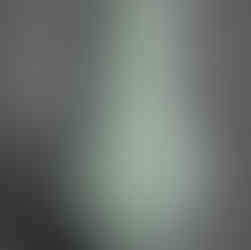

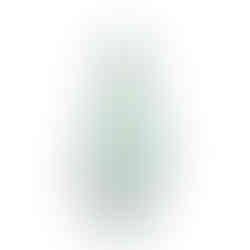


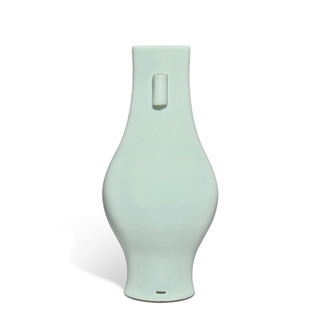

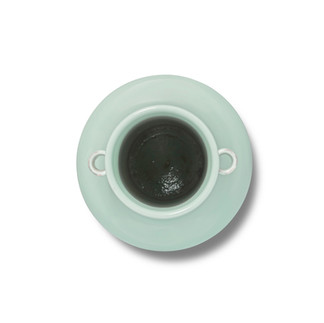

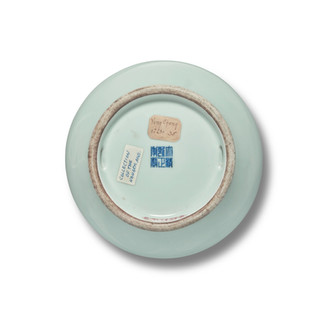







Comments